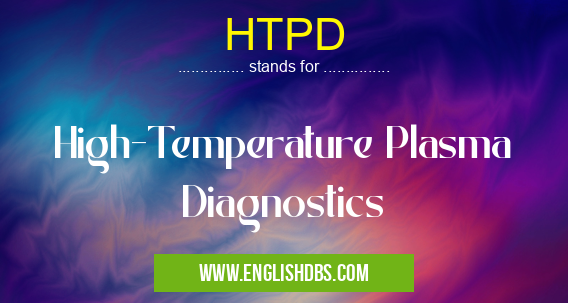What does HTPD mean in PHYSICS
HTPD stands for High-Temperature Plasma Diagnostics. It is a specialized field within plasma physics that focuses on developing and utilizing techniques to measure and analyze the properties of high-temperature plasmas. Plasmas are ionized gases composed of free electrons and ions, and they exhibit unique characteristics that are distinct from solids, liquids, and gases. High-temperature plasmas, typically characterized by temperatures exceeding millions of degrees Celsius, are encountered in various applications, including fusion energy research, astrophysics, and industrial processes.

HTPD meaning in Physics in Academic & Science
HTPD mostly used in an acronym Physics in Category Academic & Science that means High-Temperature Plasma Diagnostics
Shorthand: HTPD,
Full Form: High-Temperature Plasma Diagnostics
For more information of "High-Temperature Plasma Diagnostics", see the section below.
Techniques and Applications
HTPD employs a diverse range of diagnostic techniques to probe the properties of high-temperature plasmas. These techniques can be broadly categorized into two main types:
-
Passive Diagnostics: These methods rely on measuring the electromagnetic radiation emitted or absorbed by the plasma. Examples include spectroscopy, interferometry, and polarimetry.
-
Active Diagnostics: These methods involve actively injecting a probe into the plasma to measure its properties. Examples include Langmuir probes, magnetic probes, and particle beam diagnostics.
The choice of diagnostic technique depends on the specific parameters of interest, such as temperature, density, velocity, and electromagnetic fields. HTPD techniques are crucial for understanding the behavior of high-temperature plasmas and optimizing their performance in various applications.
Applications in Fusion Energy Research
One of the primary applications of HTPD is in fusion energy research. Fusion reactions, which combine light atomic nuclei to release vast amounts of energy, require high-temperature plasmas as the fuel. HTPD techniques are essential for monitoring and controlling the plasma conditions in fusion reactors, ensuring efficient and stable operation.
Applications in Astrophysics
HTPD also plays a vital role in astrophysics, where it helps scientists study the properties of celestial objects such as stars, galaxies, and quasars. By analyzing the electromagnetic radiation emitted by these objects, HTPD techniques provide insights into their temperature, density, composition, and magnetic fields.
Essential Questions and Answers on High-Temperature Plasma Diagnostics in "SCIENCE»PHYSICS"
What is HTPD (High-Temperature Plasma Diagnostics)?
HTPD is a specialized field of plasma physics that involves the measurement and analysis of various parameters of high-temperature plasmas. These plasmas are often created in laboratory settings using devices like tokamaks or stellarators, and are critical for studying fusion energy and other astrophysical phenomena.
What are the different techniques used in HTPD?
HTPD employs a range of techniques to measure plasma properties, including spectroscopy, interferometry, and scattering. Spectroscopy involves analyzing the emission or absorption of light by the plasma to determine its temperature, density, and composition. Interferometry measures the refractive index of the plasma to determine its density and other properties. Scattering techniques, such as Thomson scattering, use lasers to scatter light off the plasma and measure its properties.
What are the challenges in HTPD?
Working with high-temperature plasmas presents several challenges for HTPD. The extreme temperatures and radiation levels can damage diagnostic equipment, and the plasma's opacity can make it difficult to obtain clear measurements. Additionally, the rapidly changing nature of plasmas requires fast and accurate diagnostic techniques.
What are the applications of HTPD?
HTPD plays a crucial role in various fields, including fusion energy research, astrophysics, and material science. In fusion energy, HTPD helps optimize plasma conditions for fusion reactions. In astrophysics, it provides insights into the properties of stars, supernovae, and other cosmic plasmas. In material science, HTPD assists in the development of advanced materials by characterizing plasmas used in thin film deposition and other processes.
Final Words: HTPD is a critical field that enables the characterization and understanding of high-temperature plasmas. Its techniques provide valuable information about plasma properties, which is essential for optimizing applications in fusion energy research, astrophysics, and various industrial processes. Ongoing advancements in HTPD techniques continue to expand our knowledge and capabilities in the study of these complex and fascinating phenomena.
